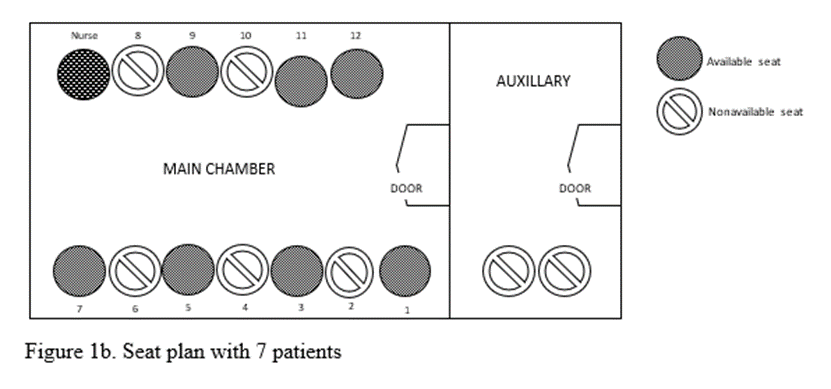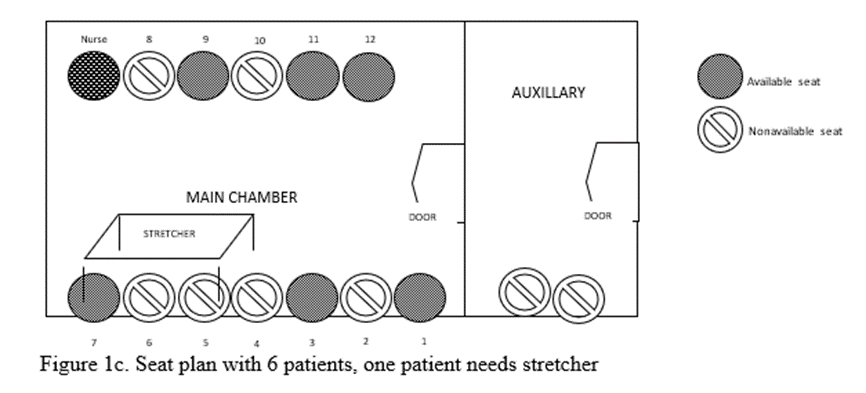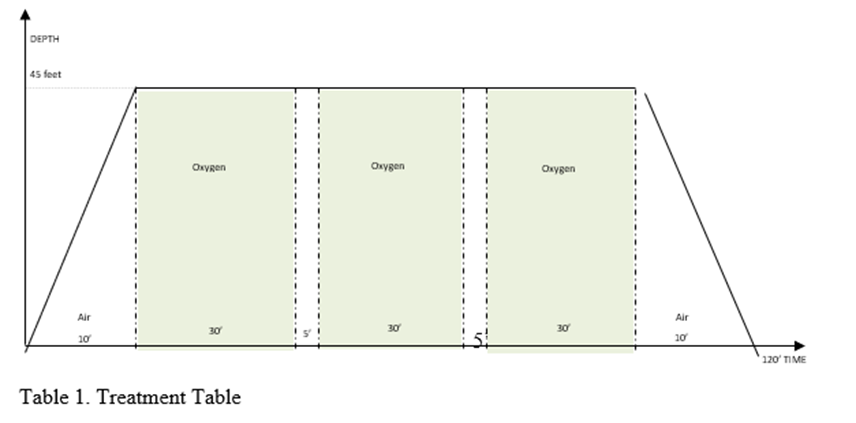Research Article | DOI: https://doi.org/10.31579/2835-7957/019
The Precautions Had Taken and Experiences Gained in a Hyperbaric Oxygen Therapy Center During Covid-19 Pandemic
- Tuna Gumus *
University of Health Sciences, Kartal Dr. Lütfi Kirdar City Hospital, Department of Undersea and Hyperbaric Medicine, Istanbul, Turkey.
*Corresponding Author: Tuna Gumus, University of Health Sciences, Kartal Dr. Lütfi Kirdar City Hospital, Department of Undersea and Hyperbaric Medicine, Istanbul, Turkey.
Citation: Tuna Gumus (2023), The Precautions Had Taken and Experiences Gained in a Hyperbaric Oxygen Therapy Center During Covid-19 Pandemic, Clinical Reviews and Case Reports, 2(1); DOI:10.31579/2835-7957/019
Copyright: © 2023, Tuna Gumus. This is an open-access article distributed under the terms of the Creative Commons Attribution License, which permits unrestricted use, distribution, and reproduction in any medium, provided the original author and source are credited.
Received: 15 April 2023 | Accepted: 01 May 2023 | Published: 08 May 2023
Keywords: Covid-19; hyperbaric oxygen
Abstract
Introduction
The aim of this study is to share our experiences with other hyperbaric clinics and healthcare professionals in their fight against other possible pandemics ahead. Hyperbaric oxygen therapy is a treatment performed in a fully enclosed pressure chamber, with multiple patients and an inside attendant nurse. During therapy, the probability of infecting each other and the inside attendant nurse is much higher than the external environment. The first detected case of the COVID-19 pandemic in Turkey which has spread around the world, was announced by the Ministry of Health on March 11. We had to take precautions in our hyperbaric oxygen therapy center.
Methods
Before the pandemic, twelve patients were treated in a session, we carry out three sessions in a day. During pandemic six patients attended the same places in the same session. Patients shortened the hospital stay and avoided contact with other patients by coming during their own session. The sphygmomanometer and blood glucose meter were cleaned after each patient use to avoid cross-contact. At the end of each session, floors and seats inside the decompression chamber were wiped. Masks and tubes were washed with glutaraldehyde free high level disinfecting solution (CidexR OPA solution). The clothes were prepared by washing and ironing before each use every day.4 COVID-19 PCR testing was requested from each new patient whose treatment was started and after the result was negative, the session was started. Patients with positive PCR test before the session were not treated.
Results
Throughout the year 2021, a total of 796 HBO therapy sessions with an average of six patients were carried out, and we had six patients whose COVID-19 PCR test became positive in three separate sessions while receiving HBO therapy despite all the precautions.
Conclusions
During the pandemic process, we continued to carry out hyperbaric oxygen therapy to emergently admitted and elective patients in our clinic by observing the social distance rules and using protective equipment during the pandemic. We observed successful results of risk and emergency planning.
Introduction
The aim of this study is to share our experiences with other hyperbaric clinics and healthcare professionals in their fight against other possible pandemics ahead. The first detected case of the COVID-19 pandemic in Turkey which has spread around the world, was announced by the Ministry of Health on March 11. The first death due to the virus in the country occurred on March 15, 2020. As of March 15, 2020 to December 31, 2021, the total number of cases reached 10.1 million and the total number of deaths reached 83,980.1 We had to take precautions in our center during the pandemic period that we have increased social distance, have worn mask and have attached importance to hand disinfection because we carry out hyperbaric oxygen (HBO) therapy with twelve patients in a closed environment for at least two hours in a multi-place hyperbaric chamber.2
Methods:
HBO therapy regulations during covid-19 pandemicIn our hospital, there is a Hypertech™ brand multi place hyperbaric oxygen chamber consisting of a main compartment for twelve people and a front compartment for two people, which is empty for emergency use only. When required, there is equipment to treat patients by intubating or treat patients on a stretcher. Before the pandemic, twelve patients were treated in one session, with daily three sessions. With the arrival of six emergency cases in three sessions after the pandemic, our treatment continued with seven patients. Therefore, distancing was increased by spacing seats apart. In case of a patient who underwent external fixation and could not complete their treatment by sitting down, they were treated on a stretcher as before the pandemic (Figure 1a-1b-1c).



Patients attended the same places in the same session. Patients shortened the hospital stay and avoided contact with other patients by coming during their own session.3 The sphygmomanometer and blood glucose meter were cleaned after each patient use to avoid cross-contact. At the end of each session, floors and seats inside the decompression chamber were wiped. Masks and tubes were washed with glutaraldehyde free high level disinfecting solution (CidexR OPA solution). The clothes were prepared by washing and ironing before each use every day.4 COVID-19 PCR testing was requested from each new patient whose treatment was started and after the result was negative, the session was started. Patients with positive PCR test before the session were not treated.5 If it was necessary to take an emergency case, the patient was treated alone after third routine session. The patient was included in routine treatment after the test result came out negative. Patients older than four years of age were treated alone. Before each session, the body temperature and blood pressure of the patients were measured and noted. Patients wore surgical masks during air brakes. During the session, the patient was ventilated and the possible viral load was reduced. Internal attendants always accompanied the treatment by wearing 3MR healthcare masks. The nurse in the outpatient setting intervened using a 3MR mask and a face shield for patients who need dressing, during the dressing process.6There was no change in the treatment protocol. Treatments continued at 45 feet for two hours (Table1).

No COVID-19 patient was ever admitted during this process. A patient intubated due to carbon monoxide intoxication was admitted once. Due to the decrease in the number of patients, emergency patients were accepted primarily. Patients with idiopathic sudden sensorineural hearing loss, central retinal artery occlusion, crush injury, limb replantation were given priority because they were urgent.7 Apart from this, we had patients who came to us with the complaints of avascular necrosis of femoral head and diabetic foot infection, whose treatment we frequently continued.
Discussion:
The COVID19 pandemic process has negatively affected all people of the world. Millions of people died. At the same time, it will affect millions of people who were infected with COVID19 and did not die, leaving both psychological and permanent sequelae for the rest of their lives. During the pandemic process, disruptions have occurred in routine health services all over the world. Elective surgeries were postponed, patients who needed to be treated in the hospital could not be hospitalized, and because outpatient clinic applications could not be made, major disruptions occurred in diagnosis and treatment. Apart from the destruction it created, this process also affected people's health by affecting the process of applying to health institutions out of fear of infection.Hyperbaric oxygen therapy is a treatment performed in a fully enclosed pressure chamber, with multiple patients and an inside attendant nurse. Routine therapy takes 120 minutes. During therapy, the probability of infecting each other and the inside attendant nurse is much higher than the external environment. All kinds of precautions have been taken to reduce the possibility of transmission in the treatments carried out during the pandemic process. Six patients were admitted to the twelve-person pressure chamber for each session. A seat gap was left between the patients. While the session was going on, both the inside attendant nurse and all the patients always wore masks. Masks were worn during the compression, decompression and air break phases of the therapy. The pressure chamber air was refreshed by frequent ventilation throughout the session. During the pandemic process, clear and accurate information transfer and trainings to patients and healthcare professionals continue by being updated. We continued the treatment of emergency patients and elective procedures in our clinic by observing the social distance rules and using protective equipment during the pandemic.
Results:
Throughout the year 2021, a total of 796 HBO therapy sessions with an average of six patients were carried out, and we had six patients whose COVID-19 PCR test became positive in three separate sessions while receiving HBO therapy despite all the precautions. One of these patients was an 8-year-old male inpatient who was operated by orthopedics due to crush injury of the left distal fibula, and a fracture of the tibia, and he was treated with HBO due to skin necrosis. On the seventh day of HBO therapy, preparing for anesthesia was started for grafting by the plastic surgeon and the PCR test was repeated before the operation. It was detected that the COVID-19 PCR test of the patient, who was completely asymptomatic. The rest of them was outpatients. HBO therapy of the patients discontinued. Because of that we did not change the daily sessions of the patients, the COVID-19 PCR test was requested only from the patients who entered that session and from all medical personnel. Since no positive case was detected, routine sessions continued the next day. The test of the mother, who was accompanying the patient while he was inpatient in the orthopedic ward, was repeated and it was negative. Research on this has been expanded. It was determined that the patient's uncle, who accompanied the patient and his mother, while carrying the patient to our hyperbaric clinic, had a positive COVID-19 PCR test. The patient and his relatives were taken to the COVID 19 ward and the quarantine process was initiated. Apart from these six patients, we did not have any patient who caught COVID-19 during HBO therapy.
Conclusions
During the pandemic process, we continued to carry out hyperbaric oxygen therapy to emergently admitted and elective patients in our clinic by observing the social distance rules and using protective equipment during the pandemic. We observed successful results of risk and emergency planning.
References
- https://covid19.saglik.gov.tr/TR-66935/genel-koronavirus-tablosu.html
View at Publisher | View at Google Scholar - Guidelines for Working in Health Institutions and Infection Control Measures During the COVID-19 Pandemic, the Study of Scientific Advisory Board, March 9, 2021. https://covid19.saglik.gov.tr/TR-66532/saglik-kurumlarinda-calisma-rehberi-ve-enfeksiyon-kontrol-onlemleri.html
View at Publisher | View at Google Scholar - El Hawa, AAA, Charipova K, Bekeny JC, & Johnson-Arbor KK. (2021). The evolving use of hyperbaric oxygen therapy during the COVID-19 pandemic. Journal of wound care. 30(Sup2), S8-11.
View at Publisher | View at Google Scholar - Lo Jing-Jou et al. (2020). Proactive COVID-19 infection prevention measures in a hyperbaric oxygen therapy center. 56(6):261.
View at Publisher | View at Google Scholar - Moon Richard E, and Lindell K Weaver. (2020). Hyperbaric oxygen as a treatment for COVID-19 infection. Undersea Hyperb Med. 47(2):77-179.
View at Publisher | View at Google Scholar - World Health Organization. Rational Use of Personal Protective Equipment for Coronavirus Disease 2019 (COVID-19).
View at Publisher | View at Google Scholar - Undersea & Hyperbaric Medical Society. Hyperbaric Oxygen Therapy Indications, 14th Edition. Available online:
View at Publisher | View at Google Scholar

 Clinic
Clinic
